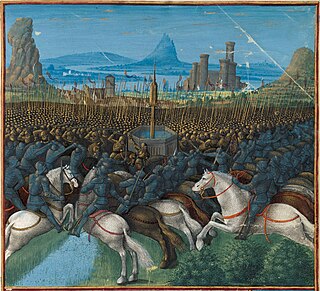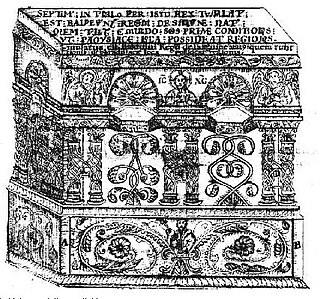
Theodoric is a Germanic given name. First attested as a Gothic name in the 5th century, it became widespread in the Germanic-speaking world, not least due to its most famous bearer, Theodoric the Great, king of the Ostrogoths.
Arculf was a Frankish churchman who toured the Holy Land around 670. Bede claimed he was a bishop from Gaul. According to Bede's Ecclesiastical History of the English People, Arculf was shipwrecked on the shore of Iona on his return from his pilgrimage. He was hospitably received by Adomnán, the abbot of the island monastery from 679 to 704, to whom he gave a detailed narrative of his travels. Adomnán, with aid from some further sources, was able to produce De Locis Sanctis, a descriptive work in three books dealing with Jerusalem, Bethlehem, other sites in the Holy Land, and briefly with Alexandria and Constantinople. Many details about Arculf's journeys can be inferred from this text.

The Battle of Cresson was a small battle between Frankish and Ayyubid forces on 1 May 1187 at the "Spring of the Cresson." While the exact location of the spring is unknown, it is located in the environs of Nazareth. The conflict was a prelude to the decisive defeat of the Kingdom of Jerusalem at the Battle of Hattin two months later.

Felix Fabri was a Swiss Dominican theologian. He left vivid and detailed descriptions of his pilgrimages to Palestine and also in 1489 authored a book on the history of Swabia, entitled Historia Suevorum.

Christian Kruik van Adrichem, or Christianus Crucius Adrichomius, was a Catholic priest and theological writer.

Francisco Quaresmio or Quaresmi, better known by his Latin name Franciscus Quaresmius, was an Italian writer and Orientalist.

The Palestine Pilgrims' Text Society (PPTS) was a text publication society based in London, which specialised in publishing editions and translations of medieval texts relevant to the history of pilgrimage to the Holy Land. Particular attention was given to accounts by pilgrims and other travellers containing geographical or topographical information, as well as those which discussed the manners and customs of the Holy Land. The original narratives were written in a variety of languages, including Greek, Latin, Arabic, Hebrew, Old French, Russian, and German.

Burchard of Mount Sion, was a German priest, Dominican friar, pilgrim and author probably from Magdeburg in northern Germany, who travelled to the Middle East at the end of the 13th century. There he wrote his book called: Descriptio Terrae Sanctae or "Description of the Holy Land" which is considered to be of "extraordinary importance".
De locis sanctis was composed by the Irish monk Adomnán, a copy being presented to King Aldfrith of Northumbria in 698. It was based on an account by the Frankish monk Arculf of his travels to the Holy Land, from which Adomnán, with aid from some further sources, was able to produce a descriptive work in three books, dealing with Jerusalem, Bethlehem, and other places in The Holy Land, and briefly with Alexandria and Constantinople. It aimed to give a faithful account of what Arculf actually saw during his journey. Many of the manuscripts contain the second earliest known map of Jerusalem
Niccolò da Poggibonsi was a Franciscan friar of the 14th century who made a famous pilgrimage to the Holy Land in 1345–50, which he described in Italian in his Libro d'oltramare.

The Shepherds' Field Chapel, or the Sanctuary of Gloria in excelsis Deo, is a Roman Catholic religious building in Beit Sahour, southeast of Bethlehem, West Bank, Palestine. The chapel commemorates the annunciation of Jesus' birth to the shepherds, said to have taken place in Beit Sahour.

Abbey of Saint Mary of the Valley of Jehosaphat was a Benedictine abbey situated east of the Old City of Jerusalem, founded by Godfrey of Bouillon on the believed site of the Tomb of the Virgin Mary.
De situ terrae sanctae is a short 6th-century report of a pilgrimage to the Holy Land. Its author is identified in a 9th-century manuscript as a German archdeacon named Theodosius.

John of Würzburg was a German priest who made a pilgrimage to the Holy Land in the 1160s and wrote a book describing the Christian holy places, the Descriptio terrae sanctae.

Rorgo Fretellus, also spelled Fetellus, was a Frankish priest in the Kingdom of Jerusalem who wrote a widely circulated description in Latin of the Christian holy places in the Holy Land, the Descriptio de locis sanctis.
Dietrich of Hohenburg was the bishop of Würzburg in 1224. From a ministerial family, he was educated in Würzburg. He was elected bishop following the death of Otto of Lobdeburg on 4 December 1223. The succession was smooth, since Dietrich had been confirmed as bishop by 8 January 1224. His episcopate was short, however. He died between 14 December 1224 and 25 February 1225. According to a medieval catalogue of bishops of Würzburg in the Bavarian State Library, however, Dietrich "was appointed bishop in the year 1223[,] held the office for one year, two months, and fourteen days [and] died 1224, in the reign of Frederick II."

The Libellus de expugnatione Terrae Sanctae per Saladinum, also called the Chronicon Terrae Sanctae, is a short anonymous Latin account of the conquests of Saladin in the Holy Land between 1186 and 1191. The core of the text was written shortly after the events it describes and then supplemented by the addition of an account of the Third Crusade early in the thirteenth century. This probably took place at Coggeshall Abbey in England. Neither the original author nor the continuator/compiler is known by name.
Historical sources of the Crusades: pilgrimages and exploration include those authors whose work describes pilgrimages to the Holy Land and other explorations to the Middle East and Asia that are relevant to Crusader history. In his seminal article in the Catholic Encyclopedia, Dominican friar and historian Bede Jarrett (1881–1934) wrote on the subject of Pilgrimage and identified that the "Crusades also naturally arose out of the idea of pilgrimages." This was reinforced by the Reverend Florentine Stanislaus Bechtel in his article Itineraria in the same encyclopedia. Pilgrims, missionaries, and other travelers to the Holy Land have documented their experiences through accounts of travel and even guides of sites to visit. Many of these have been recognized by historians, for example, the travels of ibn Jubayr and Marco Polo. Some of the more important travel accounts are listed here. Many of these are also of relevance to the study of historical geography and some can be found in the publications of the Palestine Pilgrims' Text Society (PPTS) and Corpus Scriptorum Eccesiasticorum Latinorum (CSEL), particularly CSEL 39, Itinerarium Hierosolymitana. Much of this information is from the seminal work of 19th-century scholars including Edward Robinson, Titus Tobler and Reinhold Röhricht. Recently, the Independent Crusaders Project has been initiated by the Fordham University Center for Medieval Studies providing a database of Crusaders who traveled to the Holy Land independent of military expeditions.

The Breviary of Jerusalem is a short late antique Latin guidebook for Christian pilgrims to Jerusalem.

Elzear Horn was a German Catholic friar and missionary of the Franciscan Order who is best known for his travelogues of Palestine.